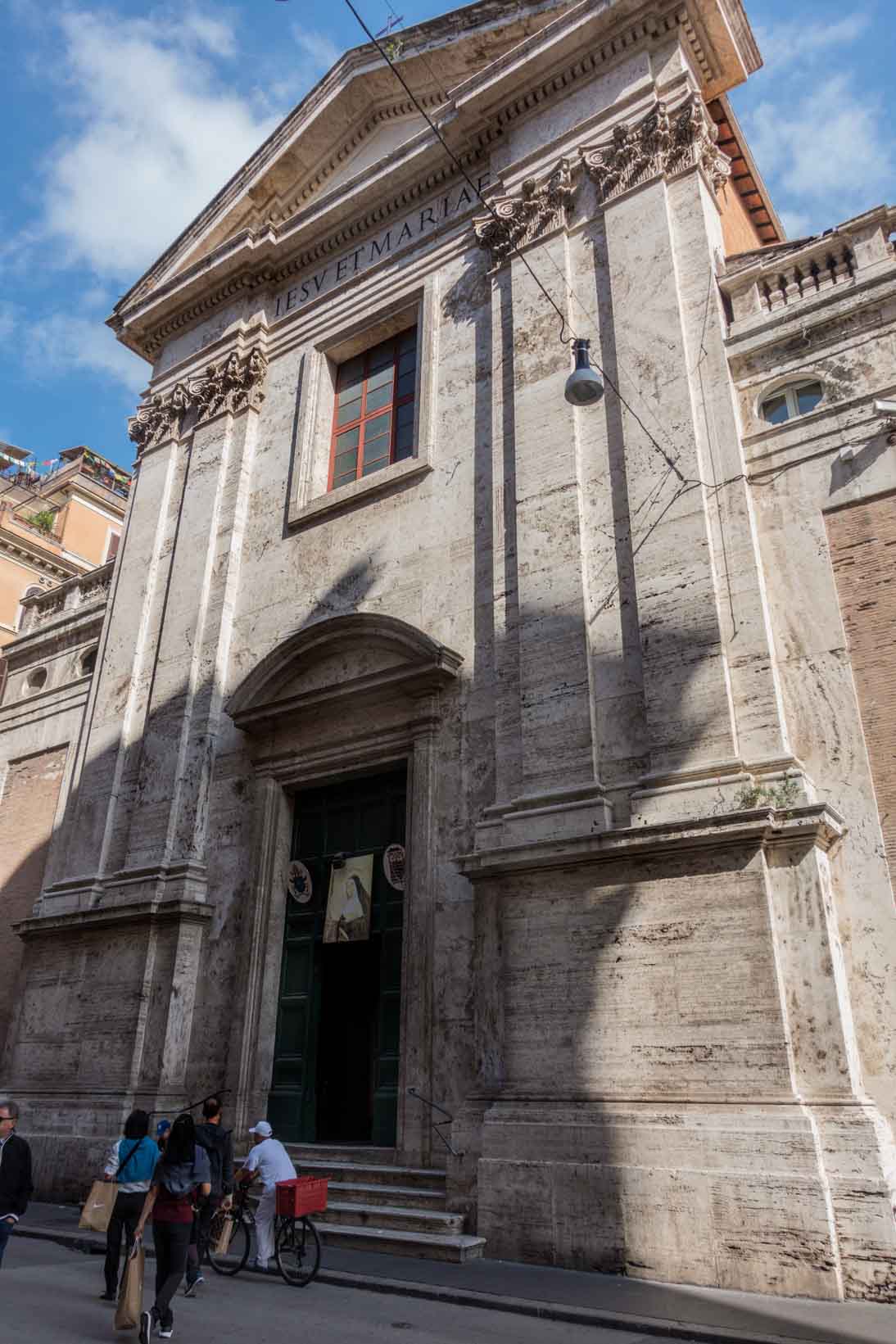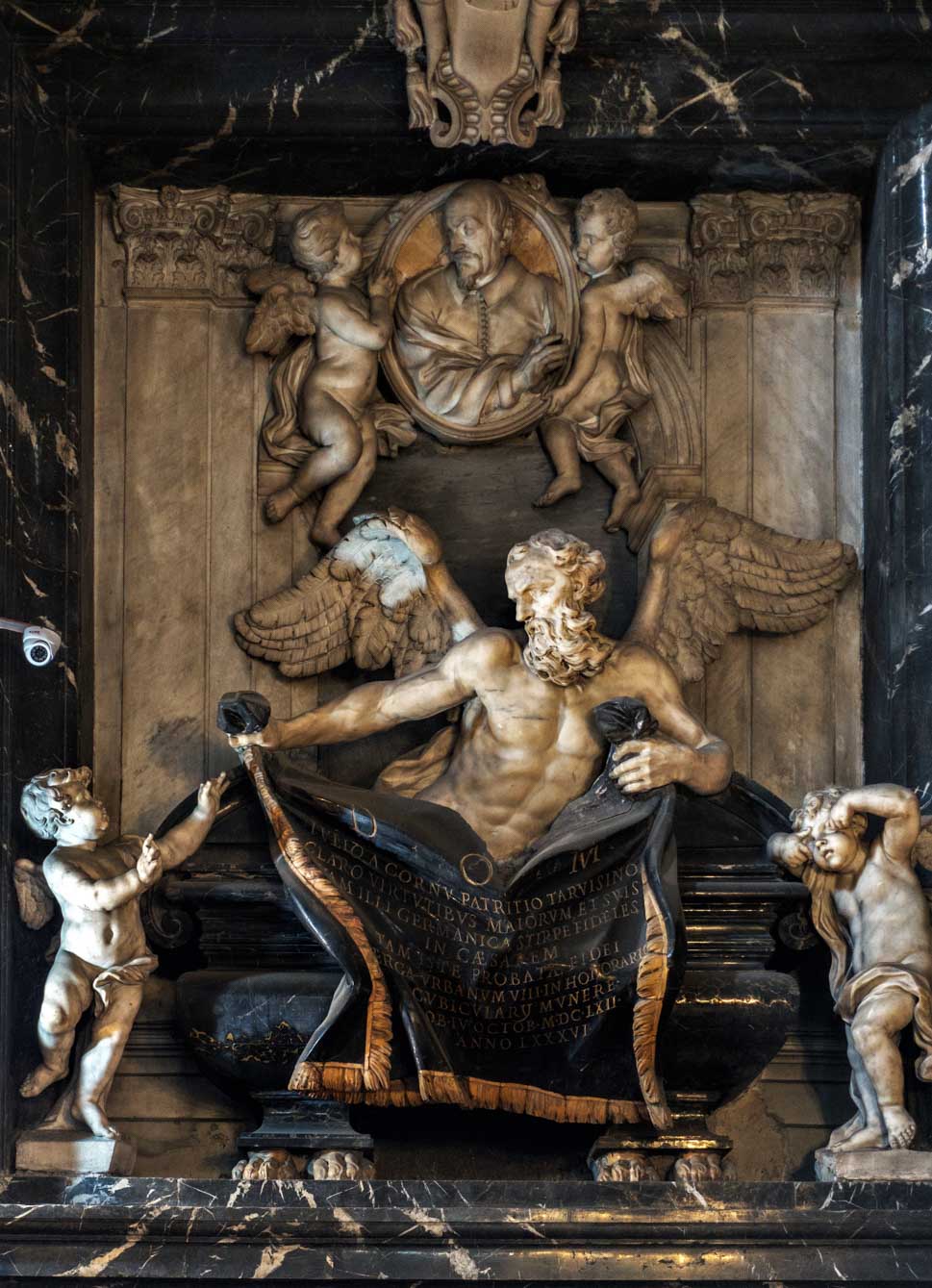
BUDOWLE & OBIEKTY Churches and chapels
Church of Santissimi Nomi di Gesù e Maria – an emotional theatre of death in a church interior

The land, where the church presently stands, was bought in 1615 by the Order of the Discalced Augustinians (a branch of the order, with a new, more severe rule, which required unconditional poverty, obedience and life of purity from its members), who wanted to build their own church and a seminary here. The works were entrusted to a little-known constructor by the name of Carlo Buzio, who created a uniform, single-nave space, covered by a cradle vault. In the end it was completed in 1674, when the modest façade made of travertine, corresponding with the poverty of the Discalced Augustinians, was finished. Its creator, this time was a renowned architect, Carlo Rainaldi. He also created the concept of the interior laid out with black, brown and pink marble and diversified with shining white statues and frescos. Six altars and a broad apse of the main altar, are located within. All of this was possible thanks to the financial support of Bishop Giorgio Bolognetti, who oblivious to the aforementioned modesty of the Discalced Augustinians, desired an interior full of splendor, seeing in it the proper means to immortalize himself and his family. He was of course driven by generosity and charity, but also by his own interests – he wanted to turn the church into a representative family chapel. And so protruding tombstone monuments were placed among the chapels – as if the deceased buried within, needed to have direct access to everything that takes place on the main altar. If that was not enough, the unusual placement of these statues above the confessionals, in the loggias destined for them, makes it seem as if after their death, the deceased wanted to participate in earthly affairs. Giorgio Bolognetti himself has his own monument a bit closer to the altar, his kneeling figure seems more focused on prayer. The balcony behind him is occupied by those who are concerned about what is happening in the front, Pietro and Francesco Bolognetti. The images which have and especially “earthly” appearance are those of Ercole and Luigi Bolognetti – the brothers of the church benefactor, who on the opposite side, on their balcony, seem to be engaged in a heated dispute, however always keeping in sight what is happening around them. Not far from them, is Mario Bolognetti, immortalized, in an almost dancing pose. The deceased are without tombstone slabs, there is also nothing here on which we can concentrate our eyes and direct our intercession prayers for their souls. Chiseled in stone, they are the observes of a theatre of life, which plays out in front of them and in which they have the starring roles Excellent characterization of the figures, pulsating with life, dramatic faces are worthy of the master Gian Lorenzo Bernini – and even he himself could not have any better captured the individual traits of the portrayed. The creators of these Baroque rarities are, however, his students - Francesco Cavallini, Ercole Ferrata and Francesco Aprile.
Above the images of the Bolognetti family chiseled out in marble, there are niches with images of saints – on the right women, on the left men, while in the window niches other images, this time of Old Testament figures. The grand window in the façade is also a Baroque means which serves to increase emotions: in the afternoon when a beam of strong light enters through it, the main altar is illuminated with a golden halo.

However, that is not all. When we turn towards the enterance, we will see a true theatre of death chiseled in stone. And this time these are also tombstone statues – but with a completely different – eschatological expression. In the name of memento mori, the personifications of Death and Time call us to reflect upon our lives – the skeleton with a smiling skull (on the left) looks upon us, jingling his hourglass as if it were a bell, while the bearded Time, from the second tombstone (on the right), waves a cloth with the inscription informing about the deceased. The fancy and imaginative tombstones were made by Ercole Ferrata and Domenico Guidi, and were designated for Giulia del Corno and Camillo del Corno.
The vault is decorated with a fresco depicting the Virgin Mary accompanied by the four evangelists. Both this painting, as well as others topping off the apse, and the altarpiece (The Coronation of Our Lady), were painted by Giacinto Brandi, whose works can also be admired in another, nearby church – San Carlo al Corso. The altar itself – the most important place in the church – fits in with the cohesive concept of the interior. The altarpiece is flanked by four, bronze, marble columns supporting a separated entablature, on which a pediment decorated with angels rests. In the lower part, on the sides, supplementing the whole, figures of St. John the Evangelist and St. John the Baptist were placed.
Może zainteresuje Cię również
Church of San Giacomo in Augusta – a pilgrim church for the body and the spirit
Zgodnie z art. 13 ust. 1 i ust. 2 rozporządzenia Parlamentu Europejskiego i Rady (UE) 2016/679 z 27 kwietnia 2016 r. w sprawie ochrony osób fizycznych w związku z przetwarzaniem danych osobowych i w sprawie swobodnego przepływu takich danych oraz uchylenia dyrektywy 95/46/WE (RODO), informujemy, że Administratorem Pani/Pana danych osobowych jest firma: Econ-sk GmbH, Billbrookdeich 103, 22113 Hamburg, Niemcy
Przetwarzanie Pani/Pana danych osobowych będzie się odbywać na podstawie art. 6 RODO i w celu marketingowym Administrator powołuje się na prawnie uzasadniony interes, którym jest zbieranie danych statystycznych i analizowanie ruchu na stronie internetowej. Podanie danych osobowych na stronie internetowej http://roma-nonpertutti.com/ jest dobrowolne.